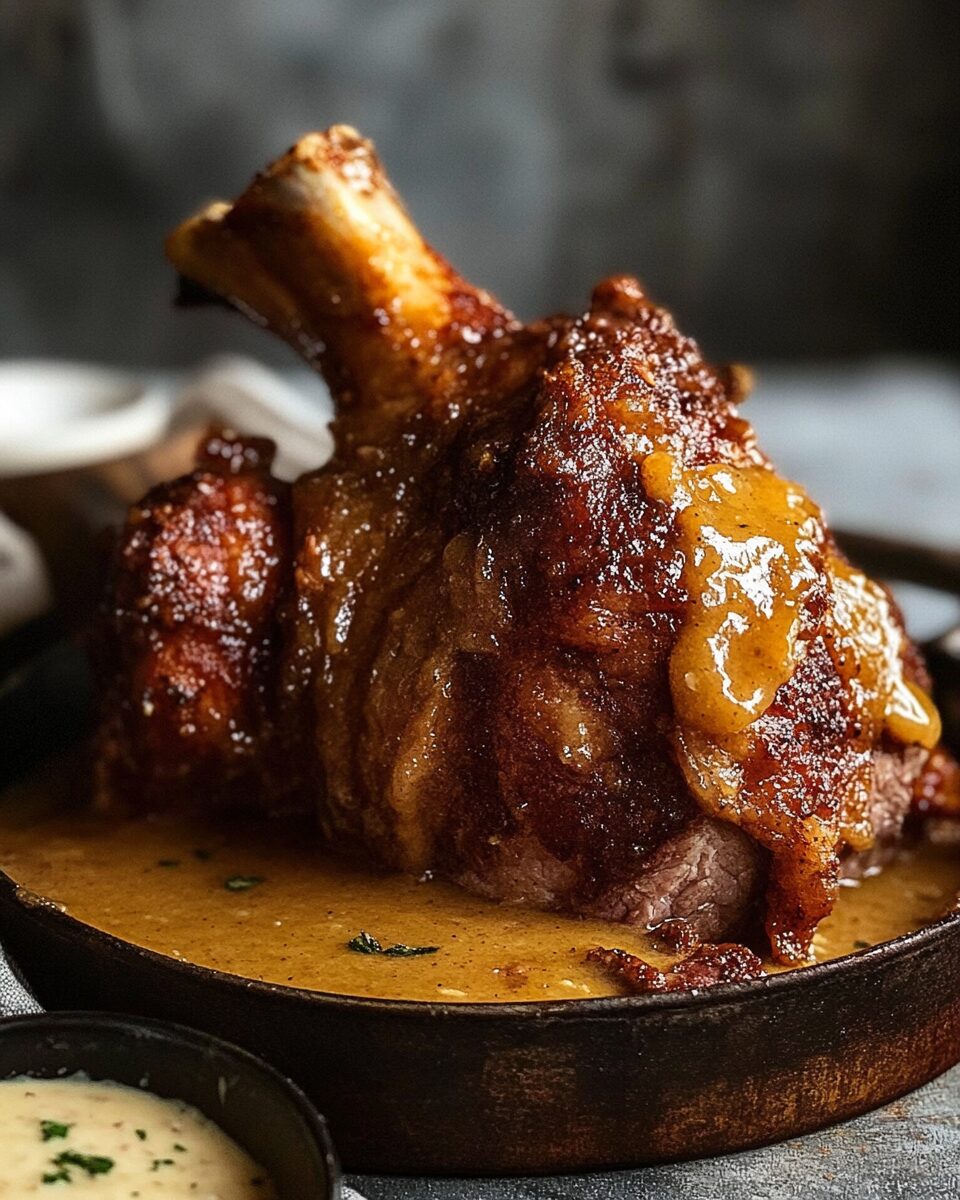This Bavarian-style Crispy Pork Knuckle is a celebration of all things savory and indulgent. Wrapped in golden, bubbly crackling and infused with aromatic juniper, caraway, and fennel, this dish brings the old-world charm of German beer halls right to your kitchen. The pork is slow-roasted until tender, then finished at high heat to ensure an irresistible crunch with every bite.
Paired with a rich and malty dark beer gravy, every mouthful is layered with deep, satisfying flavor. Whether it’s Oktoberfest or just a cozy weekend dinner, this dish is bound to impress anyone who appreciates bold, meaty flavors and crispy textures. Serve it up with potato salad or sauerkraut, and you’ve got a showstopper that feels both rustic and gourmet.
Full Recipe:
-
1 x 1.25kg / 2.5lb pork knuckle (rear leg preferred)
-
2 tbsp white vinegar
-
3 garlic cloves, cut into slivers
-
1 tsp juniper berries
-
1 tsp caraway seeds
-
1 tsp fennel seeds
-
2 tsp kosher salt
-
1 tsp black pepper
-
1 tbsp olive oil
Beer Gravy:
-
2 cups dark German beer (or dark ale)
-
2 cups low-sodium chicken stock
-
1 carrot, thickly sliced
-
1 onion, sliced with peel
-
1 head garlic, halved
-
5 juniper berries
-
2 bay leaves
-
2 tsp cornstarch
-
1/2 cup water
-
1 tsp sugar
-
1/4 – 1/2 tsp salt, to taste
Directions:
-
Prick the pork knuckle skin all over with a sharp pin or knife (about 100 times). Avoid piercing into the flesh.
-
Rub 1 tbsp vinegar into the exposed pork flesh (not the skin).
-
Insert garlic slivers into small incisions in the meat.
-
Make the rub: Crush juniper berries, caraway seeds, fennel seeds, salt, and pepper into a coarse powder.
-
Rub olive oil over the skin. Apply the seasoning mix generously all over the pork, working it into crevices.
-
Stretch the skin tight and pierce with skewers in an “X” to hold it in place.
-
Let it marinate uncovered in the fridge overnight to dry the skin and intensify flavor.
-
Preheat oven to 180°C / 350°F (160°C fan).
-
In a deep roasting pan, add all beer gravy ingredients. Place a rack on top and set the knuckle upright.
-
Roast for 2 hours 10 minutes, rotating halfway through. Internal temp should reach 85°C / 185°F.
-
Remove pork. Increase oven to 260°C / 500°F (240°C fan).
-
Brush skin with remaining vinegar. Roast again for 30 minutes, rotating tray halfway. The skin should be bubbly and crispy.
-
Rest pork knuckle for 15 minutes.
-
Meanwhile, strain pan juices into a saucepan. Simmer. Add cornstarch slurry (cornstarch + water), sugar, and salt. Simmer until gravy is a thin syrup.
-
Serve knuckle with a generous pour of dark beer gravy.
Prep Time: 20 minutes | Cooking Time: 2 hours 40 minutes | Total Time: 3 hours
Kcal: 633 kcal | Servings: 2
Introduction to Crispy German Pork Knuckle (Schweinshaxe)
The Crispy German Pork Knuckle, known locally as Schweinshaxe, is a quintessential Bavarian specialty that embodies the heartiness and rustic charm of traditional German cuisine. It’s a dish celebrated for its indulgent combination of tender, slow-roasted pork and ultra-crispy crackling skin, all served atop a rich, dark beer gravy that adds depth and boldness to every bite. Often found in beer halls across Munich and the greater Bavaria region, Schweinshaxe is not just food—it’s a cultural experience steeped in tradition, community, and culinary craftsmanship.
Unlike more refined cuts of pork, the pork knuckle (or hock) is a working muscle, filled with connective tissue, fat, and flavor. It requires time, technique, and care to transform this humble cut into a showstopping centerpiece. And when prepared correctly, it delivers both mouthwatering meat that falls off the bone and golden, bubbly crackling that shatters under your knife and crunches under your teeth.
Cultural Significance of Schweinshaxe in Germany
Schweinshaxe holds a special place in German cuisine and culture. It’s not only a mainstay during Oktoberfest, but also a year-round staple at Bavarian inns and German beer gardens. The dish captures the spirit of communal feasting—large, hearty portions meant to be enjoyed with friends, cold beer, and traditional side dishes like potato dumplings (Kartoffelknödel) or tangy sauerkraut.
It’s a symbol of regional pride, particularly in southern Germany where local butchers and chefs pass down their specific methods and seasoning blends from one generation to the next. Every bite tells a story of agricultural heritage, time-honored preparation, and the German love for quality ingredients and balanced flavors.
While the pork knuckle is sometimes misunderstood as a less desirable cut, in Germany it is treated with reverence. The emphasis is on extracting every bit of flavor and transforming it through slow cooking and skilled seasoning into a dish that rivals the finest roasts.
The Art of Achieving Perfect Crackling
One of the most iconic features of a proper Schweinshaxe is the skin. Unlike ordinary roast pork, where the crackling might be flat and firm, the pork knuckle’s skin must be blistered, puffy, and incredibly crisp—what food lovers often refer to as “bubbly crackling.”
This is no accident. Creating this result is both an art and a science. The shape of the pork knuckle, with its rounded surface and vertical positioning in the oven, presents unique challenges for even heat distribution. To counteract this, special techniques are employed such as drying out the skin overnight, pricking it with hundreds of tiny holes, and holding the skin taut using metal or bamboo skewers during roasting. This prevents sagging and wrinkling, which would otherwise ruin the crackling texture.
Moreover, the skin is blasted with high heat at the final stage of cooking—an essential step that not only crisps the outer layer but also evaporates any residual moisture. The result? A glass-like sheet of pork crackling that produces an audible crunch and provides a textural counterpoint to the juicy meat beneath.
Flavor Profile: A Symphony of German Aromatics and Beer
At the heart of this dish’s flavor is a carefully curated rub and a masterful gravy made from dark German beer. Traditional German spices such as caraway seeds, fennel, and juniper berries lend a distinctive warmth and aromatic depth to the meat. Garlic adds a savory kick, while vinegar is used to neutralize any overly “porky” aroma and enhance the overall balance of flavors.
But what truly sets this dish apart is the Bierjus, or beer gravy. This sauce, built from pan drippings, vegetables, and stock, is elevated with a hearty pour of malty German beer—usually a Dunkel or Schwarzbier. These beers bring notes of caramel, roasted grain, and a slight bitterness that complement the richness of the pork without overwhelming it. The gravy is simmered and thickened into a glossy, pourable sauce that’s both comforting and sophisticated.
The contrast between the fatty, succulent pork, crispy skin, and deep umami-laden gravy is what makes Schweinshaxe a feast for the senses. Each element is designed to highlight the others, making it a dish that’s more than the sum of its parts.
Serving Suggestions and Pairings
Traditional accompaniments for Schweinshaxe include German potato dumplings, braised red cabbage, and cucumber salad with sour cream and dill. These sides serve both a functional and cultural role—cutting through the richness of the pork and creating a balanced, satisfying plate.
In terms of beverages, it goes without saying that beer is the perfect partner. A cold glass of Weißbier, Helles, or the same dark beer used in the gravy provides a refreshing counterpoint to the warm, savory flavors on the plate.
This dish is most often enjoyed as a dinner entrée, particularly on weekends or festive occasions. In Bavarian beer halls, it’s not uncommon to see entire families or groups of friends sharing a meal centered around one or more pork knuckles. It’s indulgent, celebratory, and hearty—ideal for chilly weather and gatherings that stretch into the evening.
Tips for First-Time Cooks
If you’re attempting this dish for the first time, don’t be intimidated. While the process is somewhat lengthy, most of the cooking time is passive. The key is in the preparation: drying the skin properly, skewering it to avoid folds, and pricking the surface generously to encourage even blistering.
Use a meat thermometer to ensure the pork is fully cooked but still moist—aim for an internal temperature around 185°F (85°C). Letting the meat rest after roasting is just as critical, allowing juices to redistribute and intensifying the final flavor.
Don’t skimp on the beer you use for the gravy. A high-quality dark beer not only enhances the taste but also brings authenticity and a touch of German soul to the dish.
Why This Dish Resonates Worldwide
Though deeply rooted in Bavarian tradition, Crispy Pork Knuckle has found fans across the globe. Its appeal lies in the universal love for roasted meat and crispy textures, as well as its connection to warmth, hospitality, and togetherness. It’s a dish that doesn’t try to be delicate or refined—it embraces its rustic origins with pride.
In many ways, it mirrors the kind of cooking that’s slowly making a comeback in modern kitchens: comfort food prepared with care, tradition, and real ingredients. For chefs and home cooks alike, the opportunity to recreate a centuries-old dish with such powerful sensory impact is both a challenge and a joy.
Schweinshaxe is also incredibly versatile. While it’s an impressive centerpiece for festive occasions, it’s just as rewarding as a weekend project. It invites you to slow down, savor the process, and share something special with people you love.
Conclusion
Crispy German Pork Knuckle, or Schweinshaxe, is a culinary triumph that bridges the gap between rustic tradition and refined technique. With its juicy, flavorful meat, jaw-dropping crispy skin, and savory beer-infused gravy, it delivers everything you could ask for in a comforting, indulgent meal. It’s the kind of dish that turns dinner into a celebration, and cooking into an experience worth savoring.
Whether you’re inspired by your travels, celebrating Oktoberfest, or simply want to explore the world of traditional German cooking, Schweinshaxe is an unforgettable dish that deserves a place in your recipe repertoire. It speaks of heritage, patience, and the universal love for food that feeds both body and soul.





